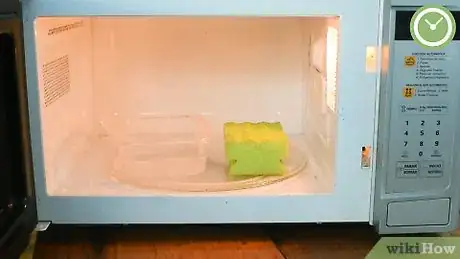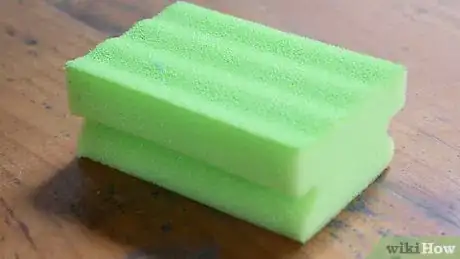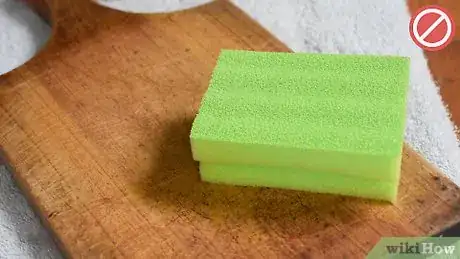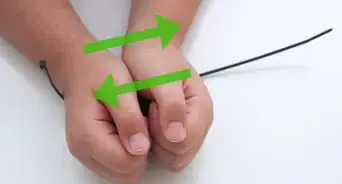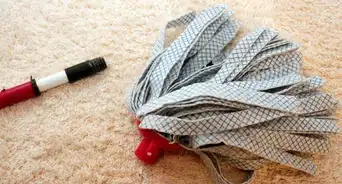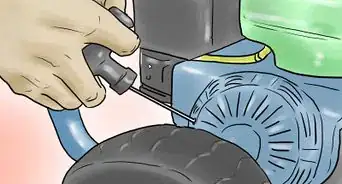This article was co-authored by Jon Gholian. Jon Gholian is a Cleaning Specialist and the Founder of Cleany, a home and office cleaning concierge service based in New York City, New Jersey & Miami. Cleany specializes in providing quality cleaning and handyman services to all their customers. All Cleany employees are insured, bonded, and professionally trained. Cleany has been featured in the New York Times, Bravo & Redfin.
wikiHow marks an article as reader-approved once it receives enough positive feedback. In this case, several readers have written to tell us that this article was helpful to them, earning it our reader-approved status.
This article has been viewed 550,775 times.
Sponges are great cleaning tools in the kitchen, but their pores can hold tiny bacteria, mold, and germs that spread easily. Luckily, you can keep your sponges nearly germ-free by zapping the bacteria in the microwave, running the sponge through the dishwasher, or soaking the sponge in bleach. Be sure to replace your sponges regularly and let them dry in between uses.
Steps
Microwaving Your Sponge
-
1Soak the sponge with water and put it in a microwave-safe bowl. Run the sponge under tap water for 30 seconds, letting it become completely saturated.[1] Don’t squeeze or wring the sponge, since you want to keep as much water in it as possible. Place the wet sponge in a glass, plastic, or ceramic bowl that's safe to go in the microwave.[2]
- If you don't have a microwave-safe bowl, you can place the sponge on a paper towel to catch any water that comes out of the sponge in the microwave.
Caution: Never microwave sponges that have metal or plastic scrubbers, as these can be fire or electrocution hazards in the microwave. It's best to wash these sponges using the dishwasher or by soaking them in a bleach solution.
-
2Place the sponge and a cup with 0.5 cups (120 mL) of water in the microwave. Position the bowl containing the sponge and the cup of water next to each other in the microwave as close together as possible. If your microwave has a spinning table, make sure both items are near the center.[3]
- The cup of water will ensure that the sponge stays moist in the microwave. If it becomes too dry, the sponge can melt or catch on fire.[4]
Advertisement -
3Microwave the sponge for 1-2 minutes.[5] Start by microwaving for one minute, which can kill up to 99% of all bacteria in the sponge. If the sponge smells bad when you open the microwave, you'll have to re-heat it. Make sure it’s still wet; re-soak the sponge if it isn't. Then, microwave it for an additional 30-60 seconds.[6]
- Some sponges naturally smell bad when they’re hot. If the sponge smells like plastic, you don’t need to reheat it.
-
4Let the sponge cool in the microwave for 10-15 minutes. Open the microwave door and let the sponge sit for at least 10 minutes before you try to pick it up or remove it from the bowl. Then, squeeze out any excess water from the sponge.[7]
- Remember, the sponge will be extremely hot once you remove it from the microwave. Don’t try to pick it up or remove it from the bowl until it has cooled down.[8]
Soaking and Washing the Sponge
-
1Make a solution of 10% bleach in a bowl. Fill a glass, plastic, or ceramic bowl with 9 parts water and 1 part bleach, and stir the mixture thoroughly. Make sure there’s enough of the solution to submerge the sponge completely in the water.[9]
- Be careful when handling bleach as it can be harmful if left on your skin for too long.
- This solution is strongly diluted, but you should wear a pair of rubber cleaning gloves to protect your skin from irritation.
-
2Soak the sponge in the bleach for 5-10 minutes. As it soaks, use a wooden spoon or spatula to press on the sponge to work the solution throughout the sponge. Every 2-3 minutes, pick it up and squeeze the liquid out of the sponge before putting it back in the solution.[10]
- This helps ensure the bleach completely penetrates the sponge, helping the removal of stains and debris.
-
3Remove the sponge from the solution and rinse it thoroughly. After at least 5 minutes, pull the sponge out of the solution and squeeze all of the liquid out. Then, rinse the sponge with warm tap water for 30 seconds, squeezing and wringing it to clear out the bleach and any loose debris.[11]
Tip: If your sponge smells bad after you rinse it, do another bleach soak, but add 1 part white vinegar to the mixture to neutralize the smell of bleach.
-
4Place the sponge on the top rack of the dishwasher for an extra deep clean. Set the dishwasher to the longest, hottest cycle, and make sure the sponge is resting on the wire rack. Select a cycle with heated drying to kill the most germs and bacteria.[12]
- This method works for almost any type of sponge, including synthetic and metal scrubbers.
Using Sponges Properly
-
1Replace your sponge every 1-2 weeks. Sponges don’t last forever, and the longer you have them, the more bacteria they hold. Try to replace your kitchen sponge weekly if you use it every day, or biweekly if you use it less often.[13]
- If your sponge starts to smell bad or becomes discolored, throw it away and replace it immediately.
-
2Place the sponge on a dish to air dry between uses. Squeeze the sponge to remove excess moisture after you rinse it. Then, leave uncovered it on a dish or the edge of the sink so the sponge can dry completely in between uses.[14]
- Mold and bacteria can multiply quickly in a wet sponge, especially in a warm, damp environment.
-
3Avoid using the sponge on surfaces that have touched raw meat. Instead of using a sponge, use other materials to clean up raw juices from meat. Opt for a dishcloth, washcloth, or paper towel to wipe down cutting boards and counters.[15]
- Disinfectant wipes are also a good option for wiping down counters that need to be cleaned. Sponges have crevices that can harbor bacteria easily, but cloths and wipes are less absorbent.
Expert Q&A
-
QuestionCan a sponge burn when you clean it in the microwave?
 Jon GholianJon Gholian is a Cleaning Specialist and the Founder of Cleany, a home and office cleaning concierge service based in New York City, New Jersey & Miami. Cleany specializes in providing quality cleaning and handyman services to all their customers. All Cleany employees are insured, bonded, and professionally trained. Cleany has been featured in the New York Times, Bravo & Redfin.
Jon GholianJon Gholian is a Cleaning Specialist and the Founder of Cleany, a home and office cleaning concierge service based in New York City, New Jersey & Miami. Cleany specializes in providing quality cleaning and handyman services to all their customers. All Cleany employees are insured, bonded, and professionally trained. Cleany has been featured in the New York Times, Bravo & Redfin.
Cleaning Specialist When using the microwave to clean a sponge, it can burn. Make sure to keep an eye on it and let it completely cool before use.
When using the microwave to clean a sponge, it can burn. Make sure to keep an eye on it and let it completely cool before use. -
QuestionHow often do I need to put a kitchen scrub brush in the dishwasher?
 Community AnswerIf it is made of plastic, be advised, it may melt in the dishwasher. If it is metal then run it once every couple of weeks to keep it from collecting mildew and bacteria.
Community AnswerIf it is made of plastic, be advised, it may melt in the dishwasher. If it is metal then run it once every couple of weeks to keep it from collecting mildew and bacteria. -
QuestionHow do I clean stains on a sponge mattress?
 Community AnswerUse baking soda/soda bicarbonate, liquid/dish soap, and a bit of water. Apply this mixture on a damp cloth and dab at stain. (Do NOT rub it in!)
Community AnswerUse baking soda/soda bicarbonate, liquid/dish soap, and a bit of water. Apply this mixture on a damp cloth and dab at stain. (Do NOT rub it in!)
Warnings
- Never microwave a dry sponge, as this can cause the material to catch on fire and damage your microwave.⧼thumbs_response⧽
References
- ↑ Jon Gholian. Cleaning Specialist. Expert Interview. 15 December 2020.
- ↑ https://www.foodnetwork.com/how-to/packages/help-around-the-kitchen/how-to-sanitize-a-kitchen-sponge
- ↑ https://waterandhealth.org/disinfect/disinfecting-sponges-microwaving-simple-solution/
- ↑ Jon Gholian. Cleaning Specialist. Expert Interview. 15 December 2020.
- ↑ Jon Gholian. Cleaning Specialist. Expert Interview. 15 December 2020.
- ↑ https://www.foodnetwork.com/how-to/packages/help-around-the-kitchen/how-to-sanitize-a-kitchen-sponge
- ↑ https://www.foodnetwork.com/how-to/packages/help-around-the-kitchen/how-to-sanitize-a-kitchen-sponge
- ↑ Jon Gholian. Cleaning Specialist. Expert Interview. 15 December 2020.
- ↑ https://www.cnet.com/how-to/how-to-sanitize-your-kitchen-sponge-in-2-minutes-or-less/
- ↑ https://www.goodhousekeeping.com/home/cleaning/a18731/how-to-clean-a-sponge/
- ↑ https://www.goodhousekeeping.com/home/cleaning/a18731/how-to-clean-a-sponge/
- ↑ https://www.foodnetwork.com/how-to/packages/help-around-the-kitchen/how-to-sanitize-a-kitchen-sponge
- ↑ https://www.eatright.org/homefoodsafety/four-steps/wash/dos-and-donts-of-kitchen-sponge-safety
- ↑ https://www.eatright.org/homefoodsafety/four-steps/wash/dos-and-donts-of-kitchen-sponge-safety
- ↑ https://www.eatright.org/homefoodsafety/four-steps/wash/dos-and-donts-of-kitchen-sponge-safety
About This Article
Sponges are porous and non-drying, making them the perfect breeding ground for bacteria. A dirty kitchen sponge can actually have up to 45 billion bacteria per centimeter on it, which means it’s one of the dirtiest items in your home. Luckily, you can easily clean a kitchen sponge in the dishwasher. Just place the sponge in the dishwasher with your dishes every few days and run a normal cycle. Then, take the sponge out and use it as you normally would. Washing your kitchen sponge in the dishwasher will kill 99.9% of the bacteria on it. For tips on soaking your sponge in bleach to clean it, read on!


